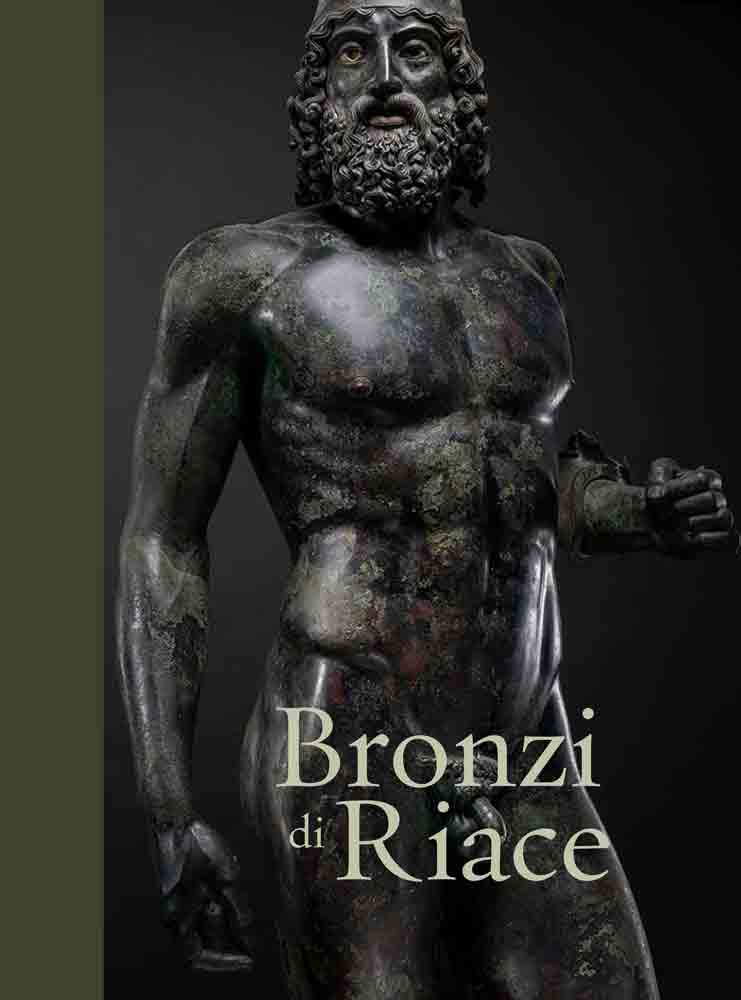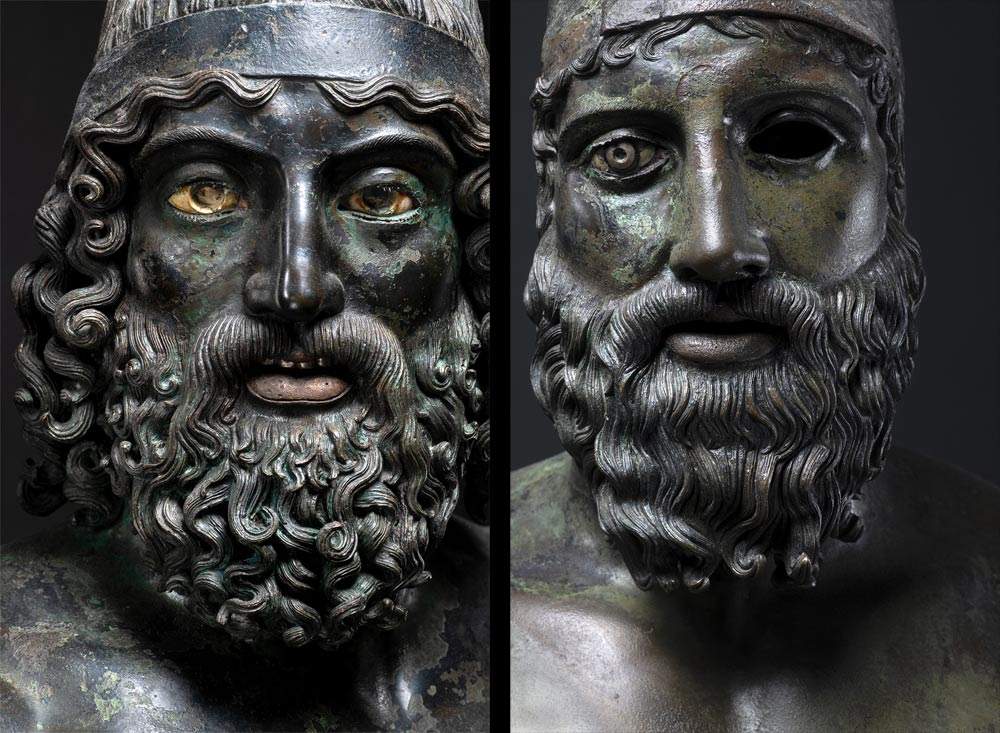Thepublishing house 5 Continents Editions presents the photographic book Bronzi di Riace, in bookstores from August 19, 2022, and dedicated to the two famous Greek sculptures preserved at the National Archaeological Museum of Reggio Calabria on the 50th anniversary of their discovery . The volume, the fourth in the Hidden Treasures series, collects a core of photographs by Luigi Spina dedicated to the famous bronze statues and accompanies the important exhibition that the National Archaeological Museum of Reggio Calabria is dedicating until Oct. 23, 2022 to the “Heroes Who Came from the Sea,” fifty years after their discovery on Aug. 16, 1972. The idea is to offer a contemporary look at some masterpieces of ancient and modern art. This approach is very close to Luigi Spina’s photographic research, which over time has given rise to an established collaboration between the publishing house and the photographer, whose shots also illustrate the first three titles in the series: Tazza Farnese (2018), Mosaico di Alessandro (2020), and San Domenico di Niccolò dell’Arca (2020).
Through Spina’s images and texts by Carmelo Malacrino and Riccardo Di Cesare, with a foreword by Culture Minister Dario Franceschini, the volume offers an in-depth visual and critical survey of one of the most celebrated and fascinating discoveries in archaeology of the last century and its significance in contemporary culture.
Known for his photographic research focused on antiquity, from classical statuary to archaeology, Luigi Spina has created a never-before-seen narrative of the Riace Bronzes, among the very few original bronze statues that have survived from antiquity to the present and have become a symbol of our cultural heritage over time. Through direct comparisons of the two sculptures-conventionally referred to as “Bronze A” and “Bronze B”-Louis Spina highlights the exceptional finish of the bronze bodies, exalting their statuesque forms, gestures and richness of detail, overcoming the two-dimensionality of photographic images. "Thebronze epidermis, which is different for each subject," explains Luigi Spina, "takes shape, density and luster, and the chiaroscuro of the bodies is tinged with the multifaceted spectrum of bronze that, as the light changes, shows body surfaces that converse with the eye of the observer."


Alongside Luigi Spina’s photographs, texts by Carmelo Malacrino and Riccardo Di Cesare lead the reader through an analysis of the celebrated masterpieces of the fifth century B.C. from the perspective of ancient history and art. In his text, Carmelo Malacrino, director of the National Archaeological Museum of Reggio Calabria, traces the circumstances of their fortuitous discovery - by Stefano Mariottini in 1972 on the seabed near Riace - and then describes the restoration work that has taken place over the years, the investigations conducted to hypothesize their realization, their exhibition history, their impact on the public internationally, and the conservation techniques adopted at the National Archaeological Museum of Reggio Calabria. On the other hand, Riccardo Di Cesare, professor of Classical and Mediterranean Archaeology at the University of Foggia, offers a rereading of the two statues by contextualizing them in the context of fifth-century B.C.E. Greek art, its interest in the human figure and related stylistic and iconographic issues, reflecting on the practices and knowledge of classical statuary workshops, and, finally, trying to answer some questions that remain unresolved.
The book accompanies the exhibition ’The Riace Bronzes’ currently running until Oct. 23 at the National Archaeological Museum in Reggio Calabria, a journey of images curated by director Carmelo Malacrino and Luigi Spina that presents sixteen large-format photographs (90 x 134 cm) in the space of the MArRC’s evocative Piacenza staircase, proposing a visual dialogue between the two sculptures.
The exhibition and the photographic book “Bronzi di Riace” are part of Bronzi50 1972-2022, the celebratory event promoted by the Region of Calabria in collaboration with the Regional Secretariat for Calabria of the Ministry of Culture, the Municipality of Reggio Calabria, the City Metropolitan City of Reggio Calabria and the Municipality of Riace, the Calabria Regional Museums Directorate, the National Archaeological Museum of Reggio Calabria, the Superintendency of Archaeology, Fine Arts and Landscape for the Metropolitan City of Reggio Calabria and the province of Vibo Valentia, the University of Calabria and Unioncamere Calabria and the Regional School Office for Calabria.
The publication Bronzi di Riace, which boasts an Italian edition, an English edition and a French edition, will be available for purchase in all Italian bookstores and on the publisher’s website starting Aug. 19.
Luigi Spina (Santa Maria Capua Vetere, 1966) offers visual research that begins with photographic series focusing on amphitheaters and the civic sense of the sacred, the links between art and faith, the search for ancient cultural identities, and the physical confrontation with classical sculpture. With 5 Continents Editions he published The Buchner Boxes (2014), Hemba (2017) and Diario Mitico (2017). With the same publishing house he inaugurated the Hidden Treasures series that boasts the following titles: Tazza Farnese, Mosaic of Alexander, San Domenico by Niccolò dell’Arca.
Carmelo Malacrino (Catanzaro, 1971) has been director of the National Archaeological Museum of Reggio Calabria since 2015. He has been a researcher and university lecturer at the University “Mediterranea” of Reggio Calabria, and a research fellow at the IUAV University of Venice. He has to his credit numerous scientific publications, study missions and has been curator of several exhibition projects.
Riccardo Di Cesare (Teramo, 1976) teaches Classical and Mediterranean Archaeology at the University of Foggia. He was a student at the Italian Archaeological School in Athens and the San Marino School of Historical Studies.
5 Continents Ed itions is anindependent publisher of art books and exhibition catalogs, founded in February 2002 in Milan by Eric Ghysels, Belgian-Armenian by birth and Italian by adoption. Today it is considered a world reference in the field of non-European arts. Its catalog includes numerous publications devoted to art in the broadest sense: archaeology, ancient, modern and contemporary art, decorative arts, fashion, design and photography. Guided with passion and enthusiasm by its publisher, the publishing house is animated by a dynamic team of professionals, enthusiasts and multilinguals. These characteristics largely facilitate its day-to-day relationships with authors, artists, foundations and museums worldwide and ensure that each volume has its own well-defined “soul.” The minimalism of the graphics, the research of the images and the prominent texts, combined with the high quality of photolith, printing and binding make each publication a tangible reflection of those forms of expression and creation whose common denominator is authenticity and soul. Bolstered by leading international distribution, the volumes are published primarily in French and English -- although there is no shortage of titles in Italian, Spanish, German, Portuguese, Arabic, Russian and Chinese -- and boast worldwide distribution. For more information, visit www.fivecontinentseditions.com.
 |
| New book on the Riace Bronzes coming out, with photographs by Luigi Spina |
Warning: the translation into English of the original Italian article was created using automatic tools. We undertake to review all articles, but we do not guarantee the total absence of inaccuracies in the translation due to the program. You can find the original by clicking on the ITA button. If you find any mistake,please contact us.